Why SFR Build-to-Rent Is a Good Investment During COVID-19

- SFR build-to-rent housing is responding to consumer preferences resulting from COVID-19.
- Both millennials and baby boomers are converging on the SFR market.
- Penciling horizontal apartments requires doing pre-investment homework.
COVID-19 has accelerated the demand of single-family rentals (SFRs) in the suburbs. An IMN panel discussed how this asset class, including build-to-rent housing, is growing in popularity. Instead of adhering to defensive measures with today’s economic uncertainties, proactive investors are finding a window of opportunities.
COVID-19 Motivated SFR Build-to-Rent Trends
Harvard Investments, a real estate investor and developer, is active in both SFRs and horizontal apartments. They have six active sites under construction in Phoenix, Las Vegas and Austin, with slightly over 1,000 units in the pipeline. Matthew Avrhami, a VP at the company, has observed an extraordinary demand in new communities in the lease-up phase, with mild concessions. He noted that SFR build-to-rent is also experiencing strong rent collections and renewals.
The pandemic seems to have created a long-term appreciation for having more space and a private backyard, said Avrhami. “Those things are more valuable today than they were six months ago.”
These trends are influencing Harvard’s investments. “We looked at our projects to re-evaluate what changes, if any, we want to make. So that if there are changes in consumer demand or preferences, we’re well-positioned to capture those competitively,” he said.
Sometimes the desired choices are obviously COVID-related, such as home offices or more room to shelter additional family members. But the company has implemented other, more subtle design concepts, such as more technologically advanced exhaust fans to improve the air quality of apartments.
Millennials and Boomers
As a self-proclaimed “finance nerd,” George Maravilla, SVP at Tower Capital, looks to data to make decisions. “Demographics are probably the biggest thing, the biggest reason we’re so bullish on build-for-rent,” he said.
Baby boomers and millennials are both attracted to this type of housing. Maravilla described how his mother wants space, a single-story home without stairs, and help in changing the lightbulbs. Meanwhile, his younger brother has grown out of the weekend pool parties, has started nesting and wants to own a dog. “So, it’s really the convergence of two demographics,” he stated.
Tower Capital focuses on growth markets. It invests in SFR build-to-rent in Phoenix, Las Vegas, Denver, and cities in Florida, the Carolinas, Texas, and in the Northwest. Both retirees as well as young professionals are gravitating to these areas.
Making Horizontal Apartments Pencil
Kathy Fettke, Co-CEO of RealWealth Network, moderated the panel. She pointed out with traditional multifamily, people build vertically to save costs. She asked how developers make the numbers work with horizontal apartments.
It’s about knowing the construction costs, rental pricing, rental growth, demand and lease-up time, said Maravilla. Know the sponsor, their experience and track record, their balance sheet, and their capabilities if something goes wrong.
In addition, this product type is very site-specific, said Avrhami. The development should match the geographic market. Study the area rents. The product should fit the area household income to ensure there are enough renters in the market. Plus, the development needs to have visibility and traffic.
On a quarterly or monthly basis, SFRs capture 8% of total deliveries and have the potential to reach 10% to 15% of the market, according to Avrhami. “There’s a ton of runway in opportunity, the more that this platform grows and demonstrates low risk for capital and high consumer demand. It’s really a competitive space for attractive returns,” he said.
You can view the full IMN webinar, here.
Learn more about Arbor Realty Trust’s single-family rental portfolio financing. Contact Arbor today to speak with an originations expert.

